Kincardineshire: Difference between revisions
No edit summary |
No edit summary |
||
| (14 intermediate revisions by 2 users not shown) | |||
| Line 1: | Line 1: | ||
{{Infobox county | {{Infobox county | ||
|name=Kincardineshire | |name=Kincardineshire | ||
|map image= | |map image=Kincardineshire Brit Isles Sect 2.svg | ||
|picture= | |picture=Craig of Garvock - geograph.org.uk - 197897.jpg | ||
|picture caption= | |picture caption=Craig of Garvock in the Howe O' the Mearns | ||
|county town=[[Stonehaven]] | |county town=[[Stonehaven]] | ||
}} | }} | ||
The '''County of Kincardine''' is a coastal [[Counties of the United Kingdom|shire]] at the edge of the [[Highlands | The '''County of Kincardine''' or '''The Mearns''' is a coastal [[Counties of the United Kingdom|shire]] at the edge of the [[Highlands]]. It lies on the [[North Sea]] coast, bounded to the north by [[Aberdeenshire]] and on the south-west by [[Angus]]. | ||
{{ | The [[county town]] is [[Stonehaven]], but Kincardineshire is named from its former county town, [[Kincardine]], on the Devilly Burn below [[Strathfinella Hill]], in the Howe of the Mearns. Kincardine was a burgh with a Castle, but when the castle was destroyed the town decayed and vanished all but the ruin of the castle and the hamlet or farmstead by the burn, the name preserved in the Mill of Kincardine, and in the name of the shire. | ||
The origin of the county's alternative name, The Mearns, is uncertain. It may be from the Gaelic words ''A' Mhaoirne'', meaning "The Stewartry". An alternative story is that it comes from "Mernia", a Scottish lord to whom the land was granted, and whose brother, Angus, had obtained the adjoining shire of [[Angus|Forfar]]. | |||
The county has four ancient burghs, as one must exclude the destroyed burgh of Kincardine, namely [[Stonehaven]], [[Banchory]], [[Inverbervie]] and [[Laurencekirk]]. | |||
==Geography== | |||
[[File:The View from Cairn O'Mount - geograph.org.uk - 16811.jpg|right|thumb|250px|From Cairn O'Mount to the Howe O' the Mearns]] | |||
In the north the county slopes from the Grampians to the picturesque and finely-wooded valley of the [[River Dee, Aberdeenshire|Dee]], and in the south it falls to the [[Howe o' the Mearns]], which is a continuation north-eastwards of [[Strathmore]]. "Howe o' the Mearns" is a name derived from a cognate of "hollow". | |||
The county is bounded by the [[North Sea]] to the east; the [[River North Esk]] to the south, across which lies [[Angus]]; and the [[River Dee, Aberdeenshire|River Dee]] for most of its northern border, although the river sweeps into Kincardineshire at [[Banchory]]. The summit of [[Mount Battock]] marks the western extremity where Kincardineshire meets both [[Angus]] and [[Aberdeenshire]]. | |||
===Coast=== | |||
The long coast is, in general, bold and rocky, but its indentations form fine natural harbours for numerous fishing villages. | |||
===Mountains and hills=== | |||
Kincardineshire is not as mountainous as its neighbours, clinging as it does close to the seashore. Nevertheless, it is a Highland county and the inland parts rise into those hills. | |||
In the west and north-west the Grampians are the predominant feature. The highest of their peaks is Mount Battock (2,552 feet), the [[county top]] and the place where three counties meet; [[Aberdeenshire]], [[Angus]] and Kincardineshire. There is a score of hills rising above 1,500 feet. In the extreme north, on the confines of Aberdeenshire, the Hill of Fare, famous for its sheep walks, attains an altitude of 1,545 feet | |||
===Rivers and lochs=== | |||
[[File:River Dee at Banchory.jpg|right|thumb|250px|The Dee at Banchory]] | |||
The principal rivers are: | |||
*[[Bervie Water]] (20 miles long) flowing south-eastwards to the North Sea | |||
*The [[Carron Water, Kincardineshire|Carron Water]] (85 miles) entering the sea at Stonehaven. | |||
*The Cowie (13 miles) | |||
*The Dye (15 miles) rising on [[Mount Battock]] and ending its course in the Feugh | |||
*The [[Water of Feugh]] (20 miles) taking a north-easterly direction and falling into the Dee at [[Banchory]], and forming near its mouth a beautiful cascade. | |||
*[[Luther Water]] (14 miles) springing not far from the castle of Drumtochty and meandering pleasantly to its junction with the North Esk | |||
Two rivers serve as boundary streams during part of their course: | |||
*The [[River Dee, Aberdeenshire|Dee]] forming the northern border with Aberdeenshire, and | |||
*The [[River North Esk|North Esk]] forming the border of Angus. | |||
The Dee is known as an Aberdeenshire river, but it crosses into Kincardineshire for a few miles, passing through Banchory, thereafter forming the border with Aberdeenshire to its mouth in Aberdeen. | |||
Loch Loirston, in the parish of Nigg, and Loch Lumgair, in Dunnottar parish, both small, are the only lakes in the shire. | |||
===Glens and cliffs=== | |||
Of the glens Glen Dye in the north centre of the county is remarkable for its beauty, and the small Den Fenella, to the south-east of Laurencekirk, contains a picturesque waterfall. Its name perpetuates the memory of Fenella, daughter of a thane of Angus, who was slain here after betraying Kenneth II to his enemies, who (according to local tradition) made away with him in Kincardine Castle. | |||
Excepting in the vicinity of St Cyrus, the coast from below Johnshaven to Girdle Ness presents a bold front of rugged cliffs, with an average height of from 100 to 250 feet, interrupted only by occasional creeks and bays, as at Johnshaven, Gourdon, Bervie, Stonehaven, Portlethen, Findon, Cove and Nigg. | |||
===Geology=== | |||
The Highland Fault which traverses Scotland from shore to shore passes through Kincardineshire from Craigeven Bay, about a mile north of Stonehaven. On the northern side of this line are the old crystalline schists of the Dalradian group and on the southern side Old Red Sandstone occupies all the remaining space. Good exposures of the schists are seen, repeatedly folded, in the cliffs between Aberdeen and Stonehaven. They consist of a lower series of greenish slates and a higher, more micaceous and schistose series with grits; bands of limestone occur in these rocks near Banchory. Besides the numerous minor flexures the schists are bent into a broad synclinal fold which crosses the county, its axis lying in a south-westerly-north-easterly direction. | |||
Rising through the schists are several granite masses, the largest being that forming the high ground around Mount Battock. South of the Dee are several smaller masses, some of which have been extensively quarried. | |||
The lower part of the Old Red Sandstone consists of flags, red sandstones and purple clays in great thickness; these are followed by coarse conglomerates, well seen in the cliff at Dunnottar Castle, with ashy grits and some thin sheets of diabase. The diabase forms the Bruxie and Leys Hills and some minor elevations. Above the volcanic series more red sandstones, conglomerates and marls appear. The Old Red Sandstone is folded synclinally in a direction continuing the vale of Strathmore; south of this is an anticline, as may be seen on the coast between St Cyrus and Kinneff. Glacial striae on the higher ground and debris on the lower ground show that the direction taken by the ice flow was south-eastward on the hills but as the shore was approached it gradually took on an easterly and finally a northerly direction. | |||
==History== | |||
The annals of Kincardineshire as a whole are almost blank. The county belonged of old to the Picts and apparently was overrun for a brief period by the Romans. In the parish of Fetteresso are the remains of the camp of Raedykes, in which, according to tradition, the Caledonians under Galgacus were lodged before their battle with Agricola. It is also alleged that in the same district Malcolm I was killed (954) whilst endeavouring to reduce the unruly tribes of this region. The antiquities consist mostly of stone circles, cairns, tumuli, standing stones and a structure in the parish of [[Dunnottar]] vaguely known as a "Picts' kiln". | |||
King William the Lion in the 12th century established a Royal Hunting Park in the Mearns, at Kincardine. Kincardine and its castle soon became the location for the sheriff and his courts, and thus Kincardine became the county town and for the old name "The Mearns" was substituted a new name: Kincardineshire.<ref>Howe o' the Mearns Heritage Club</ref> | |||
By an extraordinary reversion of fortune however, the town which gave the shire its name has practically vanished. It stood about two miles north-east of [[Fettercairn]],<ref>{{cite web| url=http://www.fife.50megs.com/fettercairn-anecdote.htm| title=Fettercairn, Scotland| accessdate=2008-10-08}}</ref> but by the end of the 16th century had declined to a mere hamlet, being represented now only by the ruins of the royal castle and an ancient burial-ground. The Bruces, earls of Elgin, also bear the title of earl of Kincardine. | |||
In 1296, King John I, John Balliol, wrote a letter of surrender from the castle to Edward I of England after a short war which marked the beginning of the wars between the kingdoms which dragged on bloodily through the Middle Ages. The only visible sign of its previous existence is the ruin by the Devilly Burn below Strathfinella Hill, near the Mill of Kincardine which preserves its name, as does the shire. | |||
In 1600, Parliament caused the government of Kincardineshire to be conducted at the [[Stonehaven Tolbooth]]. | |||
==Ancient roads== | |||
[[File:Gillybrands - geograph.org.uk - 1742980.jpg|right|thumb|250px|Track of the Causey Mounth Road at Gillybrands Farm]] | |||
The ancient Causey Mounth road was built on high ground to make passable this only available mediæval route from coastal points south to [[Aberdeen]]. This ancient passage specifically connected the [[Bridge of Dee]] to Muchalls Castle, Cowie Castle (and effectively Dunnottar Castle). The route was that taken by the Earl Marischal and Marquess of Montrose when they led a Covenanter army of 9,000 men in the first battle of the Civil War in 1639.<ref>Archibald Watt, ''Highways and Byways around Kincardineshire'', Stonehaven Heritage Society (1985)</ref> | |||
Elsick Mounth is a prehistoric trackway used by the Caledonian tribes as well as the Roman army in their northern invasion of the Highlands.<ref>C.Michael Hogan, [[http://www.megalithic.co.uk/article.php?sid=18037 ''Elsick Mounth'', Megalithic Portal], A. Burnham ed. (2005)</ref> | |||
==Towns and villages== | |||
[[File:Stonehaven-Square.jpg|right|thumb|250px|Stonehaven]] | |||
*[[Banchory]] | |||
*[[Inverbervie]] | |||
*[[Laurencekirk]] | |||
*[[Newtonhill]] | |||
*[[Portlethen]] | |||
*[[Stonehaven]] (''[[county town]]'') | |||
===Parishes=== | |||
{{parishliststart}} | |||
*[[Arbuthnott]] | |||
*[[Banchory-Devenick]] | |||
*[[Banchory-Ternan]]* | |||
*[[Benholm]] | |||
*[[Bervie]] | |||
*[[Dunnottar]] | |||
*[[Durris]] | |||
*[[Fettercairn]] | |||
*[[Fetteresso]] | |||
*[[Fordoun]] | |||
*[[Garvock]] | |||
*[[Glenbervie]] | |||
*[[Kinneff and Catterline]] | |||
*[[Laurencekirk]] | |||
*[[Maryculter]]* | |||
*[[Marykirk]] | |||
*[[Nigg, Kincardineshire|Nigg]] | |||
*[[St Cyrus]] | |||
*[[Strachan]] | |||
{{parishlistend}} | |||
<nowiki>*</nowiki>: Extends into Aberdeenshire.<br /> | |||
Additionally, the parishes of [[Aberdeen]] and [[Drumoak]] extend into Kincardineshire. | |||
==Sights of Kincardineshire== | |||
[[File:Dunnotar Castle.jpg|right|thumb|200px|Dunnottar Castle]] | |||
{{UKPlacesKey}} | |||
*{{i-Castle}} [[Allardice Castle]] | |||
*{{i-Castle}} [[Cowie Castle]] (ruins) | |||
*Catterline | |||
*{{i-Castle}} [[Dunnottar Castle]] | |||
*{{i-Castle}} [[Fetteresso Castle]] | |||
*Fowlsheugh Nature Reserve | |||
*[http://www.grassicgibbon.com/ Lewis Grassic Gibbon Centre], [[Arbuthnott]] | |||
*{{i-Castle}} [[Kincardine Castle]] (ruins) | |||
*{{i-Castle}} [[Muchalls Castle]] | |||
*Portlethen Moss | |||
*The Tolbooth, [[Stonehaven]] | |||
*{{i-House}} [[Ury House]] | |||
==References== | |||
{{reflist}} | |||
===Books=== | |||
*Jervise, A: History and Traditions of the Lands of the Lindsays (1853) | |||
*History and Antiquities of the Mearns (1858) | |||
*Memorials of Angus and the Mearns (1861) | |||
*Anderson, J: The Black Book of Kincardineshire (Stonehaven, 1879) | |||
*Mollyson, C A: The Parish of Fordoun (Aberdeen, 1893) | |||
*Cameron, A C: The History of Fettercairn (Paisley, 1899) | |||
{{British county}} | {{British county}} | ||
Latest revision as of 12:58, 4 November 2016
| Kincardineshire United Kingdom | |
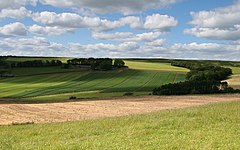 Craig of Garvock in the Howe O' the Mearns | |
|---|---|
| Laus Deo (Praise to God) | |
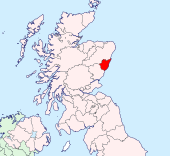
| |
| [Interactive map] | |
| Area: | 380 square miles |
| Population: | 77,670 |
| County town: | Stonehaven |
| County flower: | Clustered bellflower [1] |
The County of Kincardine or The Mearns is a coastal shire at the edge of the Highlands. It lies on the North Sea coast, bounded to the north by Aberdeenshire and on the south-west by Angus.
The county town is Stonehaven, but Kincardineshire is named from its former county town, Kincardine, on the Devilly Burn below Strathfinella Hill, in the Howe of the Mearns. Kincardine was a burgh with a Castle, but when the castle was destroyed the town decayed and vanished all but the ruin of the castle and the hamlet or farmstead by the burn, the name preserved in the Mill of Kincardine, and in the name of the shire.
The origin of the county's alternative name, The Mearns, is uncertain. It may be from the Gaelic words A' Mhaoirne, meaning "The Stewartry". An alternative story is that it comes from "Mernia", a Scottish lord to whom the land was granted, and whose brother, Angus, had obtained the adjoining shire of Forfar.
The county has four ancient burghs, as one must exclude the destroyed burgh of Kincardine, namely Stonehaven, Banchory, Inverbervie and Laurencekirk.
Geography
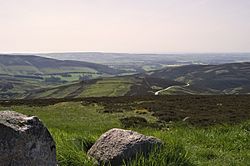
In the north the county slopes from the Grampians to the picturesque and finely-wooded valley of the Dee, and in the south it falls to the Howe o' the Mearns, which is a continuation north-eastwards of Strathmore. "Howe o' the Mearns" is a name derived from a cognate of "hollow".
The county is bounded by the North Sea to the east; the River North Esk to the south, across which lies Angus; and the River Dee for most of its northern border, although the river sweeps into Kincardineshire at Banchory. The summit of Mount Battock marks the western extremity where Kincardineshire meets both Angus and Aberdeenshire.
Coast
The long coast is, in general, bold and rocky, but its indentations form fine natural harbours for numerous fishing villages.
Mountains and hills
Kincardineshire is not as mountainous as its neighbours, clinging as it does close to the seashore. Nevertheless, it is a Highland county and the inland parts rise into those hills.
In the west and north-west the Grampians are the predominant feature. The highest of their peaks is Mount Battock (2,552 feet), the county top and the place where three counties meet; Aberdeenshire, Angus and Kincardineshire. There is a score of hills rising above 1,500 feet. In the extreme north, on the confines of Aberdeenshire, the Hill of Fare, famous for its sheep walks, attains an altitude of 1,545 feet
Rivers and lochs
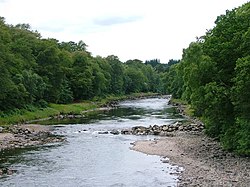
The principal rivers are:
- Bervie Water (20 miles long) flowing south-eastwards to the North Sea
- The Carron Water (85 miles) entering the sea at Stonehaven.
- The Cowie (13 miles)
- The Dye (15 miles) rising on Mount Battock and ending its course in the Feugh
- The Water of Feugh (20 miles) taking a north-easterly direction and falling into the Dee at Banchory, and forming near its mouth a beautiful cascade.
- Luther Water (14 miles) springing not far from the castle of Drumtochty and meandering pleasantly to its junction with the North Esk
Two rivers serve as boundary streams during part of their course:
- The Dee forming the northern border with Aberdeenshire, and
- The North Esk forming the border of Angus.
The Dee is known as an Aberdeenshire river, but it crosses into Kincardineshire for a few miles, passing through Banchory, thereafter forming the border with Aberdeenshire to its mouth in Aberdeen.
Loch Loirston, in the parish of Nigg, and Loch Lumgair, in Dunnottar parish, both small, are the only lakes in the shire.
Glens and cliffs
Of the glens Glen Dye in the north centre of the county is remarkable for its beauty, and the small Den Fenella, to the south-east of Laurencekirk, contains a picturesque waterfall. Its name perpetuates the memory of Fenella, daughter of a thane of Angus, who was slain here after betraying Kenneth II to his enemies, who (according to local tradition) made away with him in Kincardine Castle.
Excepting in the vicinity of St Cyrus, the coast from below Johnshaven to Girdle Ness presents a bold front of rugged cliffs, with an average height of from 100 to 250 feet, interrupted only by occasional creeks and bays, as at Johnshaven, Gourdon, Bervie, Stonehaven, Portlethen, Findon, Cove and Nigg.
Geology
The Highland Fault which traverses Scotland from shore to shore passes through Kincardineshire from Craigeven Bay, about a mile north of Stonehaven. On the northern side of this line are the old crystalline schists of the Dalradian group and on the southern side Old Red Sandstone occupies all the remaining space. Good exposures of the schists are seen, repeatedly folded, in the cliffs between Aberdeen and Stonehaven. They consist of a lower series of greenish slates and a higher, more micaceous and schistose series with grits; bands of limestone occur in these rocks near Banchory. Besides the numerous minor flexures the schists are bent into a broad synclinal fold which crosses the county, its axis lying in a south-westerly-north-easterly direction.
Rising through the schists are several granite masses, the largest being that forming the high ground around Mount Battock. South of the Dee are several smaller masses, some of which have been extensively quarried.
The lower part of the Old Red Sandstone consists of flags, red sandstones and purple clays in great thickness; these are followed by coarse conglomerates, well seen in the cliff at Dunnottar Castle, with ashy grits and some thin sheets of diabase. The diabase forms the Bruxie and Leys Hills and some minor elevations. Above the volcanic series more red sandstones, conglomerates and marls appear. The Old Red Sandstone is folded synclinally in a direction continuing the vale of Strathmore; south of this is an anticline, as may be seen on the coast between St Cyrus and Kinneff. Glacial striae on the higher ground and debris on the lower ground show that the direction taken by the ice flow was south-eastward on the hills but as the shore was approached it gradually took on an easterly and finally a northerly direction.
History
The annals of Kincardineshire as a whole are almost blank. The county belonged of old to the Picts and apparently was overrun for a brief period by the Romans. In the parish of Fetteresso are the remains of the camp of Raedykes, in which, according to tradition, the Caledonians under Galgacus were lodged before their battle with Agricola. It is also alleged that in the same district Malcolm I was killed (954) whilst endeavouring to reduce the unruly tribes of this region. The antiquities consist mostly of stone circles, cairns, tumuli, standing stones and a structure in the parish of Dunnottar vaguely known as a "Picts' kiln".
King William the Lion in the 12th century established a Royal Hunting Park in the Mearns, at Kincardine. Kincardine and its castle soon became the location for the sheriff and his courts, and thus Kincardine became the county town and for the old name "The Mearns" was substituted a new name: Kincardineshire.[1]
By an extraordinary reversion of fortune however, the town which gave the shire its name has practically vanished. It stood about two miles north-east of Fettercairn,[2] but by the end of the 16th century had declined to a mere hamlet, being represented now only by the ruins of the royal castle and an ancient burial-ground. The Bruces, earls of Elgin, also bear the title of earl of Kincardine.
In 1296, King John I, John Balliol, wrote a letter of surrender from the castle to Edward I of England after a short war which marked the beginning of the wars between the kingdoms which dragged on bloodily through the Middle Ages. The only visible sign of its previous existence is the ruin by the Devilly Burn below Strathfinella Hill, near the Mill of Kincardine which preserves its name, as does the shire.
In 1600, Parliament caused the government of Kincardineshire to be conducted at the Stonehaven Tolbooth.
Ancient roads

The ancient Causey Mounth road was built on high ground to make passable this only available mediæval route from coastal points south to Aberdeen. This ancient passage specifically connected the Bridge of Dee to Muchalls Castle, Cowie Castle (and effectively Dunnottar Castle). The route was that taken by the Earl Marischal and Marquess of Montrose when they led a Covenanter army of 9,000 men in the first battle of the Civil War in 1639.[3]
Elsick Mounth is a prehistoric trackway used by the Caledonian tribes as well as the Roman army in their northern invasion of the Highlands.[4]
Towns and villages
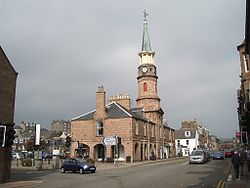
Parishes
*: Extends into Aberdeenshire.
Additionally, the parishes of Aberdeen and Drumoak extend into Kincardineshire.
Sights of Kincardineshire
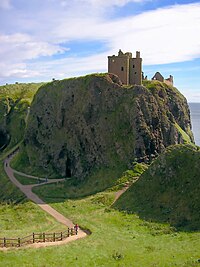
| Key | |
| Cathedral/Abbey/Priory | |
| Accessible open space | |
| Amusement/Theme Park | |
| Castle | |
| Country Park | |
| Historic Scotland | |
| Forestry Commission | |
| Heritage railway | |
| Historic House | |
| Museum (free/not free) | |
| National Trust for Scotland | |
| Zoo | |
 Allardice Castle
Allardice Castle Cowie Castle (ruins)
Cowie Castle (ruins)- Catterline
 Dunnottar Castle
Dunnottar Castle Fetteresso Castle
Fetteresso Castle- Fowlsheugh Nature Reserve
- Lewis Grassic Gibbon Centre, Arbuthnott
 Kincardine Castle (ruins)
Kincardine Castle (ruins) Muchalls Castle
Muchalls Castle- Portlethen Moss
- The Tolbooth, Stonehaven
 Ury House
Ury House
References
- ↑ Howe o' the Mearns Heritage Club
- ↑ "Fettercairn, Scotland". http://www.fife.50megs.com/fettercairn-anecdote.htm. Retrieved 2008-10-08.
- ↑ Archibald Watt, Highways and Byways around Kincardineshire, Stonehaven Heritage Society (1985)
- ↑ C.Michael Hogan, [Elsick Mounth, Megalithic Portal, A. Burnham ed. (2005)
Books
- Jervise, A: History and Traditions of the Lands of the Lindsays (1853)
- History and Antiquities of the Mearns (1858)
- Memorials of Angus and the Mearns (1861)
- Anderson, J: The Black Book of Kincardineshire (Stonehaven, 1879)
- Mollyson, C A: The Parish of Fordoun (Aberdeen, 1893)
- Cameron, A C: The History of Fettercairn (Paisley, 1899)
| Counties of the United Kingdom |
|---|
|
Aberdeen • Anglesey • Angus • Antrim • Argyll • Armagh • Ayr • Banff • Bedford • Berks • Berwick • Brecknock • Buckingham • Bute • Caernarfon • Caithness • Cambridge • Cardigan • Carmarthen • Chester • Clackmannan • Cornwall • Cromarty • Cumberland • Denbigh • Derby • Devon • Dorset • Down • Dumfries • Dunbarton • Durham • East Lothian • Essex • Fermanagh • Fife • Flint • Glamorgan • Gloucester • Hants • Hereford • Hertford • Huntingdon • Inverness • Kent • Kincardine • Kinross • Kirkcudbright • Lanark • Lancaster • Leicester • Lincoln • Londonderry • Merioneth • Middlesex • Midlothian • Monmouth • Montgomery • Moray • Nairn • Norfolk • Northampton • Northumberland • Nottingham • Orkney • Oxford • Peebles • Pembroke • Perth • Radnor • Renfrew • Ross • Roxburgh • Rutland • Selkirk • Shetland • Salop • Somerset • Stafford • Stirling • Suffolk • Surrey • Sussex • Sutherland • Tyrone • Warwick • West Lothian • Westmorland • Wigtown • Wilts • Worcester • York |